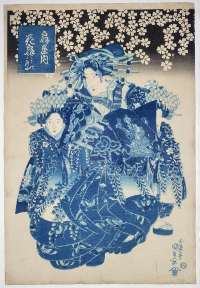Why were prints produced in just blue
In the current update there is a Kunisada aizuri-e. Why were prints produced in just blue ?
The history of ukiyo-e is one marked by the development and assimilation of technical innovations in the printmaking process as well as the adaption of the numerous regulations imposed by the Tokugawa bakufu (shogunate) as a result of the economic climate of the Edo period (1600-1868). Mismanagement of the economy by the government and weak Shoguns led to the issuing, intermittently, of regulatory edicts in an attempt to raise funds, to cut spending and to encourage thrift.

The impression offered here shows all the attributes of the earliest printing: Extremely beautiful and careful wiping of the blue block to render the currents of water; careful modulation of the gradation on the fish at top and also on the sea-weed at the bottom. The later printings – even the first with Matsui Eikichi – lack finesse in the printing of the water and in the republished version there is often no attempt to gradate the foreground sea-weed. The pigments are also of a finer quality on this early state , a better red being used on Cho Jun’s trousers. It was the job of the printers to breathe life, so to speak, into the image, to give form and depth by means of skilled bokashi; to augment a design by wiping on clouds or spraying pigment to imitate dust or snow. This all took time rather than relying on a key-block outline and blocks of colour.The only other difference, of course, between early and late printings is the quality of the impression. The more prints that were pulled, the more the blocks wore down producing weak outlines.
These decrees were also frequently aimed at raising moral standards, and as ukiyo-e – related as it was to the less esteemed merchant class – prospered, it became one of the prime targets of the government. The bakufu viewed the widespread appeal and production of ukiyo-e as a barometer of the excesses of the period, and also as a potential instrument which could be used to satirize the establishment. Prohibitions were placed on paper quality, pigments, the number of blocks to be used, as well as subject matter. These statutes were, at certain times, vigorously applied, but depending on prevailing economic conditions, short-lived. Nonetheless resourceful publishers, and perhaps artists and artisans, were quick to find ways of evading them. In this way ukiyo-e periodically underwent a change, usually resuming its original form after the relaxation of the edicts, but having added further techniques and imagery to its repertoire. Two examples are the benigirai-e (red-hating pictures) and aizuri-e (prints produced almost entirely in blue) which were the outcome of edicts limiting colours on prints and books. Aizuri-e were issued in response to the Tempo Reforms of the early 1840s (Tempo era, 1830-44), and reached, in some cases, a high degree of sophistication, using as many as five blocks with varying hues of blue and only the smallest area of, usually, red.